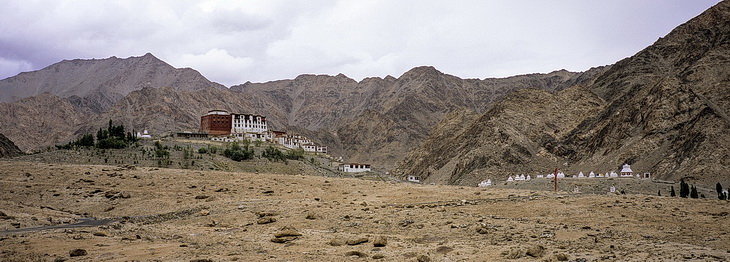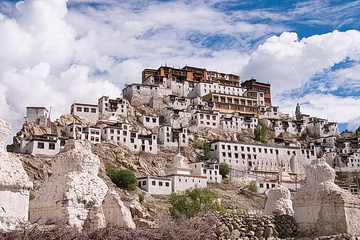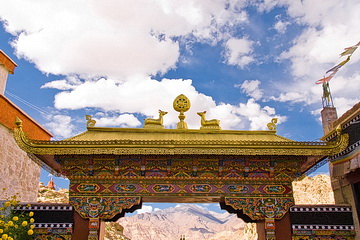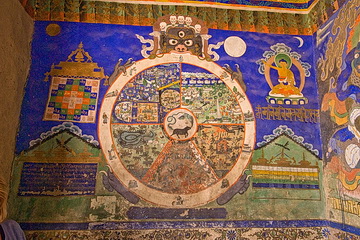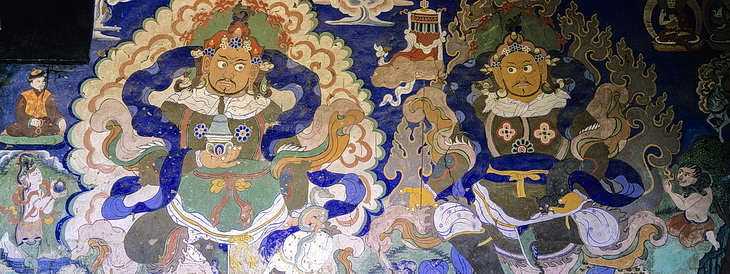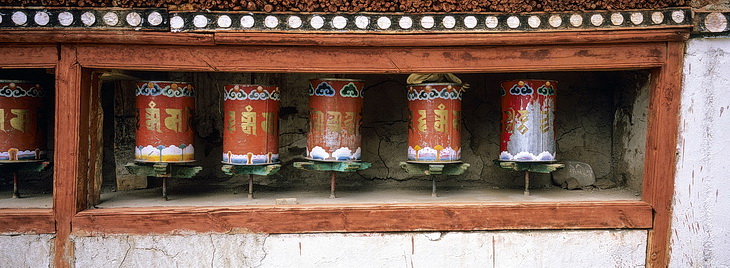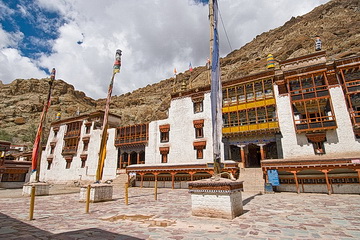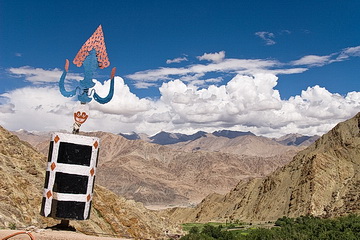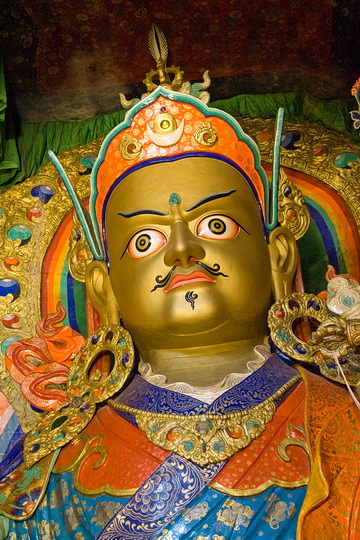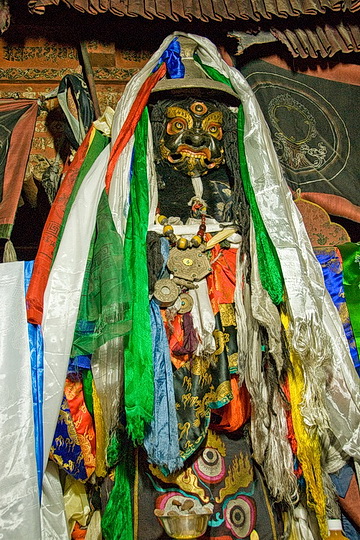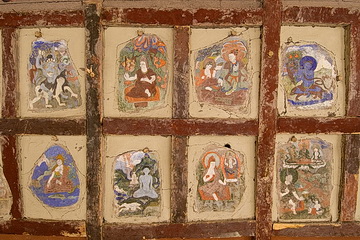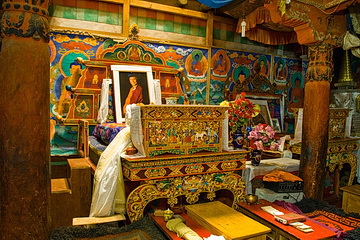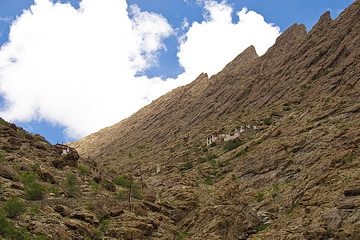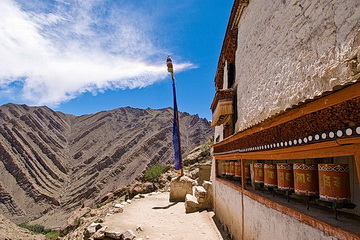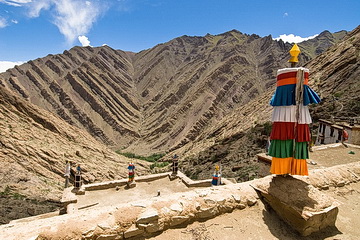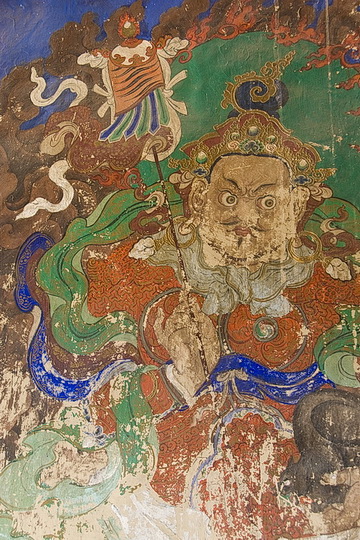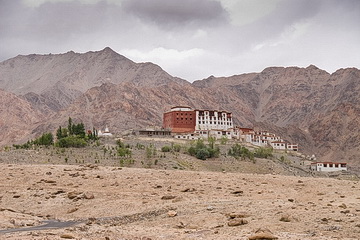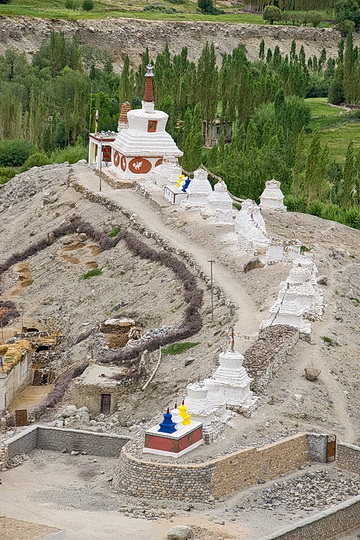Klöster im Industal
Schon im 8. Jahrhundert kam der Buddhismus vom heutigen Swat Tal im Norden Pakistans nach Ladakh, Tibet, Mustang, Nepal, Sikkim und Bhutan, nachdem der tibetische König Trisong Detsen Hauptschüler von Guru Rinpoche (Padmasambhawa) geworden war. Guru Rinpoche gründete die Alte Schule (Nyingma) des tibetischen Buddhismus. Um das Jahr 1000 entstanden die drei Neuen Schulen Kagyü, Kadam und Sakya und um 1400 die Gelug Schule. Besonders präsent in Ladakh und Zanskar sind Gelugpa (Gelbmützen) Klöster, sowie Klöster der Drikung Kagyü und Drukpa Kagyü (beide Rotmützen). Gelug (die Tugendhaften) ist die von Tsongkhapa reformierte Kadampa Schule von Atisha, alle Kagyü Unterschulen gehen auf Schüler von Gampopa zurück (11. Jahrhundert). Gampopa und Rechungpa waren Schüler Milarepas und dessen Lehrer war Marpa der Übersetzer, welcher die höchsten Lehren Buddhas, u.a. die 6 Yogas von Naropa, aus Indien nach Tibet holte.
Zwei Tagesausflüge führen uns zunächst das Indus-Tal flussaufwärts zum Kloster Thikse, nach Shey, der früheren Residenz der Ladakh-Könige sowie dem Kloster Hemis. Am zweiten Tag besuchen wir die Klöster Spituk und Phyang, wenige Kilometer flussabwärts von Leh.
Already during the eighth century Buddhism reached Ladakh, Tibet, Mustang, Nepal, Sikkim and Bhutan after the Tibetan King Trisong Detsen had become the main disciple of Guru Rinpoche (Padmasambhava). Guru Rinpoche founded the Old school (Nyingma School) of Tibetan Buddhism. Around the year 1000 the New Schools Kagyü, Kadam und Sakya developed and about 1400 the Gelug School was founded. Especially in Ladakh and Zanskar monasteries of the Gelug (yellow hats) as well as of the Drikung and Drukpa Kagyus (both red hats) are dominating. Gelug (Virtuous) is Atisha´s Kadampa Sect after being reformed by Tsongkhapa. All Kagyu Subschools originate in students of Gampopa (11th century). Gampopa and Rechungpa were the main students of Milarepa whose teacher was Marpa the Translator, who brought the highest Buddhist teachings from India to Tibet.
From Leh you can easily reach the nearby monasteries Thikse and Hemis, Spituk and Phyang as well as Shey, the former residence of the Ladakh kings.
Thikse
Das Kloster Thikse erinnert an den Potala Palast in Lhasa. Tsongkhapa, der Gründer der Gelugpa Schule, ließ dem König von Ladakh durch seinen Schüler Sherab Sangpo eine kleine Statue von Tsepame, dem Buddha des grenzenlosen Lebens überbringen, um den Buddhismus in Ladakh zu fördern. Sherap Sangpo baute daraufhin 1433 den ersten Tempel der Gelugpas bei Stagmo. Palden Sangpo, ein Schüler Sherab Sangpos, gründete das Kloster Thikse etwa in der Mitte des 14. Jahrhunderts.
Thikse Monastery resembles the Potala Palace in Lhasa. Tsongkhapa the founder of the Gelugpa School of Tibetan Buddhism handed a small statue of Tsepame, the Buddha of limitless life to his student Sherab Sangpo in order to carry it to the King of Ladakh and to promote Buddhism in this country. Thereupon Sherab Sangpo was constructing the first Gelugpa tempel near Stakmo. Around the center of the 14th century Thikse Monastery was founded by Palden Sangpo, a student of Sherab Sangpo.
Die 15 m hohe Statue des zukünftigen Buddha Maitreya wurde 1970 anlässlich eines Besuchs des Dalai Lama gebaut.
The 15 m statue of the future Buddha Maitreya was built in 1970 on the occasion of a visit of the Dalai Lama.
Verdeckt hinter der Gebetstrommel befindet sich ein Bild Tsongkapas. Das Lebensrad symbolisiert Samsara, den Kreislauf der bedingten Existenz, welcher durch die Illusion des Ichs in Gang gehalten wird.
A picture of Tsongkapa is hidden behind a prayer wheel. The wheel of life is symbolizing Samsara, the cycle of dependent origination.
Gebetstrommeln in Thikse, die mit Mantrarollen gefüllt sind.
Prayer wheels in Thikse filled with mantra rolls.
Blick vom Dach des Klosters Thikse nach Südosten auf das Industal.
View from the roof of Thikse monastery in south-eastern direction across the Indus valley.
Shey
Der Königspalast und das Kloster von Shey, 15 km östlich von Leh, wurden 1655 von Deldon Namgyal, dem Sohn des Königs von Ladakh Senge Namgyal, erbaut. Der Palast verfällt zur Zeit immer mehr. Aus dem 10. Jahrhundert stammt das Relief der 5 Dyanibuddhas. Sie symbolisieren die Umwandlung der 5 Hauptstörgefühle in die 5 Weisheiten. Links Stupas bei Shey, in der Gompa des historischen Buddha Shakyamuni ein Bild des 12. Drukpa Rinpoches und eine Mandalaschale für Spenden.
The King´s Palace and the monastery of Shey 15 kms east of Leh were constructed in 1655 by Deldon Namgyal, the son of Senge Namgyal, the King of Ladakh. The palace is deteriorating more and more. The relief of the five Dhyani Buddhas symbolizing the conversion of the 5 main disturbing emotions into the 5 wisdoms is dsting back to the 10th century. On the left Stupas near Shey, in the gompa of the historical Buddha Shakyamuni an image of the 12th Drukpa Rinpoche and a mandala bowl for donations.
Hemis
In der Meditationshöhle etwa 3 km oberhalb des Hemis Klosters soll schon der indische Pandit Naropa seinem buddhistischen Lehrer Tilopa im 11. Jahrhundert begegnet sein. Anfang des 13. Jahrhunderts hielt sich dann der Große Meister Götzangpa - Schüler von Tsangpa Gyare, dem Gründer der Drukpa Kagyü Schule (Rotmützen), in der Höhle in Zurückziehung auf. Das Kloster Hemis wurde 1633 von Taktsang Repa unter der Schirmherrschaft des Königs Senge Namgyal gegründet. Hemis liegt etwa 75 km südöstlich von Leh und ist für seine Festspiele, die Cham Tänze der Lamas, bekannt.
In the meditation cave about 3 kms above Hemis monastery it is said that the Indian Pandit Naropa had met his Buddhist teacher Tilopa in the 11th century. At the beginning of the 13th century the Buddhist Master Gotzangpa stayed in this cave for retreat. He was a student of Tsangpa Gyare, the founder of the Drukpa Kagyu School (red hats). Hemis monastery was founded 1633 by Taktsang Repa under the sponsership of King Senge Namgyal. Hemis, 75 kms from Leh, is famous for its festivities and lama dances.
Padmasambhava (Guru Rinpoche), der Tantrische Meister und Gründer der Nyingma Übertragung des Buddhismus in Tibet (um 750). Rechts ein Dharmaschützer, erkennbar am Weisheitsauge auf der Stirn.
Padmasambhava (Guru Rinpoche) the Tantric Master and founder of the Buddhist Nyingma Transmission in Tibet. The image on the right shows a protector of the Buddha's teachings with a wisdom eye on his forehead.
Alte Fresken von Mahasiddhas (Große Verwirklicher) und Sitz des 12. Drukpa Rinpoches, dem Oberhaupt der Drukpa Kagyü Schule.
Old frescos auf Mahasiddhas (Great Realized Meditators) and seat of the 12th Drukpa Rinpoche, leader of the Drukpa Kagyu Order.
Etwa 3 km oberhalb von Hemis liegt die Einsiedelei Götzang mit der Höhle in der Götzang Gönpo Dorje, ein großer Mahamudrameister, in der ersten Hälfte des 13. Jahrhunderts meditierte. Mahamudra (Sanskrit) bedeutet Grosses Siegel der Verwirklichung und bezeichnet die höchsten Lehren Buddhas, die direkte Erfahrung des Geistes jenseits aller Konzepte.
Three kilometers above Hemis lies the hermitage of Gotzang where Gotzang Gonpo Dorje, a great Mahamudra master was meditating in the cave during the first half of the 13th century. Mahamudra (Sanskrit) means Great Seal of realization and denotes the highest teachings of Buddha, the direct experience of the nature of mind beyond all concepts.
Spituk
Das Kloster Spituk ist das älteste Kloster Ladakhs und liegt auf einem Hügel im Industal 5 km südlich von Leh. Gegründet wurde Spituk Ende des 11. Jahrhunderts von Od-de, einem Zeitgenossen des indischen erleuchteten Lehrers Atisha, der auf Bitte des Königs Yeshe Ö nach Tibet übersiedelte und dort auch den Übersetzer Rinchen Sangpo traf. Dieser nannte das Kloster "beispielgebend" (=spituk) für die zukünftige Entwicklung des Buddhismus in Tibet. Im 15. Jahrhundert wurde Spituk renoviert und erweitert und von den Nachfolgern der Kadampa Schule, den Gelugpas (Gelbmützen) übernommen.
Spituk Monastery is the oldest monastery of Ladakh, situated on a hillock in the Indus Valley 5 kms south of Leh. The founder of Spituk was Od-de, a comtemporary of the Indian enlighted teacher Atisha. Due to the request of the Tibetan King Yeshe O Atisha spent his last 17 years in Tibet, where he also met the great translator Rinchen Sangpo. The latter called Spituk "exemplary" (or "spituk", the meaning of "exemplary") for the future development of Buddhism in Tibet. In the 15th century Spituk was renovated, enlarged and administrated by the Gelugpa School, the successors of Athisha´s Kadampa School.
Phyang
Das Kloster Phyang, etwa 20 km westlich von Leh, ist der Hauptsitz der Drikung Kagyü Übertragungslinie des tibetischen Buddhismus in Ladakh. Der Gründer im 16. Jahrhundert war Denma Kunga Drakpa, der spirituelle Lehrer des ladakhischen Königs Tashi Namgyal.
Phyang monastery, about 20 kms west of Leh is the main seat of the Drikung Kagyu lineage of Tibetan Buddhism in Ladakh. The founder in the 16th century was Denma Kunga Drakpa, the spiritual teacher of King Tashi Namgyal.
Stein mit einer Darstellung des Buddha Amitabha (erkennbar an der Meditationshaltung der Hände) und Motiv mit Stupas unterhalb des Klosters (im unteren Panoramabild rechts).
Stone showing Buddha Amitabha in meditation gesture and a photograph of the stupas underneath the monastery (in the panorama below the stupas are to the right).
